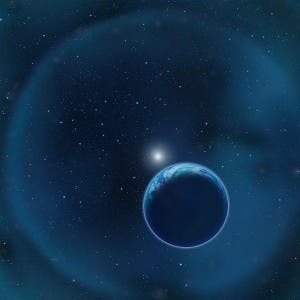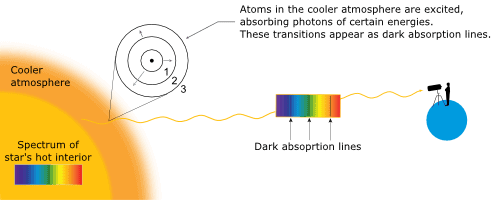
Pollution! While industrial pollution threatens the climate on our home planet Earth, astronomers at the Harvard-Smithsonian Center for Astrophysics (CfA) have come up with a way to put industrial pollution to good use. In a recent paper, Henry Lin, Gonzalo Gonzalez Abad, and Avi Loeb suggest that we should start looking for pollution on other planets to see if we can detect industrialized alien civilizations using the James Webb Space Telescope soon-to-be-launched in 2018.
The SETI Institute has been searching for extraterrestrial intelligence and other forms of life for the past 30 years, but so far, they have not found any conclusive evidence for life beyond Earth. They have been primarily looking for radio waves and infrared light in the electromagnetic spectrum using the Allen Telescope Array. These searches have the potential to find evidence of aliens communicating with each other or even artificial light sources – both features that we commonly use on our planet. SETI’s lack of success may be due to a lack of intelligent life in the nearby vicinity of Earth. Still, it is possible that our search technique is not good enough and could be improved – such as by searching a wider range of frequencies, among other things. It is also possible that intelligent life once existed in the places where we are looking, but no longer does today and therefore, is no longer broadcasting any signals.
The James Webb Space Telescope (JWST) offers a new opportunity to improve our search that will compliment SETI’s work and other related efforts. JWST is Hubble’s successor as the next big space telescope. One of its major science goals is to study the formation of planetary systems with planets in a star’s habitable zone – like the Earth – where liquid water can exist. Though, Lin, Abad, and Loeb point out that JWST has the added bonus of direct detection methods of habitability as well.

Past studies have explored using JWST to find O2 – oxygen molecules – since they play a significant role in allowing life to exist on Earth. However, Lin, Abad, and Loeb suggest that in addition to O2, we also try looking for a different type of molecules – chlorofluorocarbons (CFCs). CFCs are pollutants that can be used for refrigeration, among other applications. Since we know that CFCs can damage the ozone layer, the world has regulated the use of CFCs since the 1970s, trying to replace them with less-damaging chemicals. Though, as this previous ZME article discusses, related ozone-damaging chemicals are still in use. Avi Loeb makes a joke in a CfA press release, saying that “people often refer to ETs as ‘little green men,’ but the ETs detectable by this method [of looking for CFCs] should not be labeled ‘green’ since they are environmentally unfriendly.”
Unlike friendlier chemicals such as O2 that astronomers can use to detect many forms of life, CFCs can only be used to detect intelligent life – specifically life that is polluting its own atmosphere. However, nature does not produce CFCs at any significant rate. If we detect O2, it could be from a natural process. On the other hand, if we detect a high concentration of CFCs – with our current knowledge of natural planetary processes – this would be a sure indicator that they are coming from an industrial source, and not a natural one.
As with any other molecule – including O2 – and with many other telescopes, astronomers can use JWST to identify CFCs by looking for spectral lines. All objects radiate some amount of thermal energy depending on their temperature. This energy is emitted as light and is spread out over a wide, continuous range of frequencies. In this case, the planet is emitting a continuous spectrum that acts as a background behind its much cooler and less dense atmosphere. Since the atmosphere is in our line of sight towards the planet, it absorbs some of the light at specific frequencies depending on the specific atoms and molecules present. When looking at the whole spectrum, these absorption features look like lines.
Typically, it is difficult to identify specific lines in planetary atmospheres outside our solar system because the planets orbit around stars that are so much brighter. However, this problem can be solved if the central star were a smaller white dwarf star. This previous ZME article talks about why white dwarfs – dead stars about the size of the Earth – would be great targets for looking for life, albeit completely different from our own Sun.
Lin, Abad, and Loeb determine that if we target planets orbiting white dwarfs, JWST will be able to identify CFC concentrations that are at least 10 times higher than CFC levels on Earth with relative ease and without wasting telescope time. If we keep polluting our own atmosphere, the Earth’s CFC concentration will increase tenfold in about 1000 years. So with this method, we are essentially trying to find a civilization like us – (1) except at least 1000 years more advanced, (2) that still pollutes its atmosphere, and (3) lives in a solar system with a white dwarf at the center.
We would not expect to find an alien civilization that matches our current technological state exactly, so the extra 1000 years of advancement is not a big issue. Our civilization has industrialized in just the last few hundred years and will probably be very different several hundred years from now, a relatively short amount of time compared to the age of our solar system or any other. If there are aliens out there, chances are they will be technologically much more advanced or not industrialized or intelligent at all.
Despite what Avi Loeb said about “little green men,” it is possible that aliens might be intentionally polluting their atmosphere. We consider CFCs to be pollutants on Earth because we live in a stable climate that is suitable for life and the use of CFCs threatens that stability. Though, advanced alien civilizations living in a different type of climate might be interested in using CFCs to heat their own planet or possibly even another uninhabitable planet in an effort to terraform it and make it more habitable.
Regardless of their use, CFCs can last a very long time, with half-lives up to 100,000 years. If we can find O2 and CFCs on the same planet, that would be a great indicator of life. Alternatively, if we are able to find CFCs on a planet without O2, this may indicate a planet where life once existed within the last hundred thousand years, but no longer does.
There is no good way to tell how much more likely it will be for us to find signs of life with JWST in 2018. The ability to detect industrialized life within the last 100,000 years instead of just the present-day should improve our chances at least somewhat. Yet, all of our previous attempts have still been unsuccessful. Nonetheless, with the launch of JWST, CFCs will try to change that.
The paper can be found here:
http://arxiv.org/pdf/1406.3025v2.pdf



